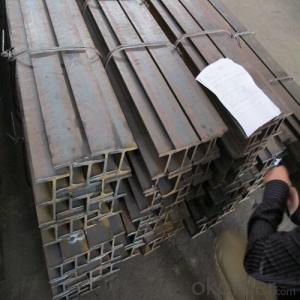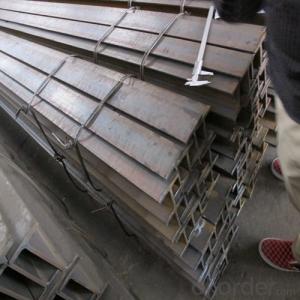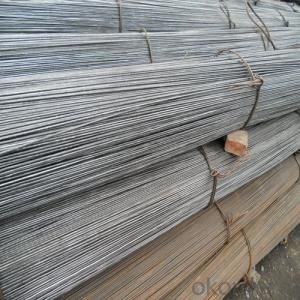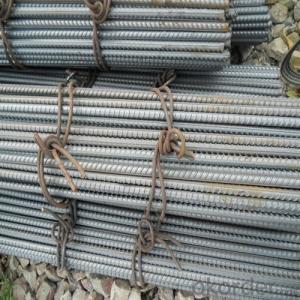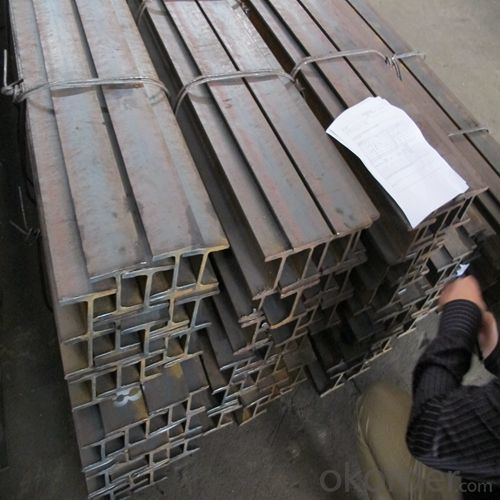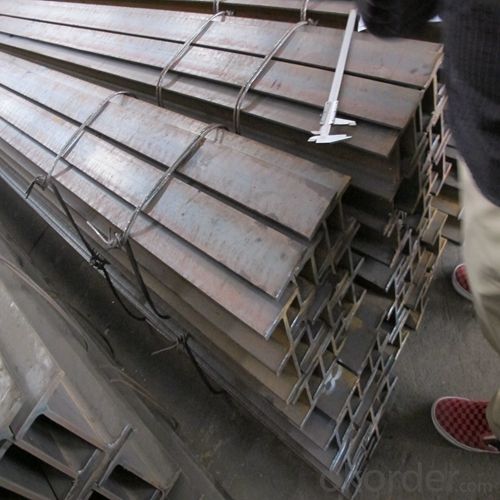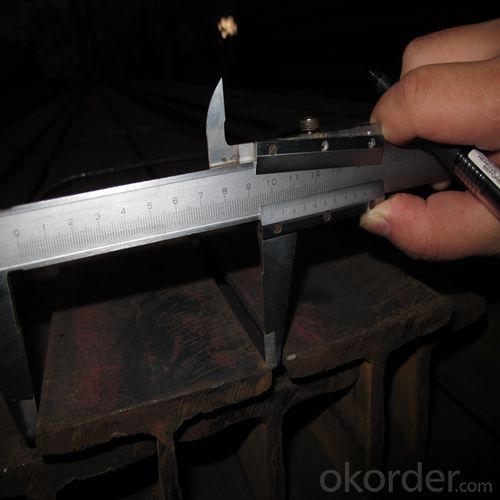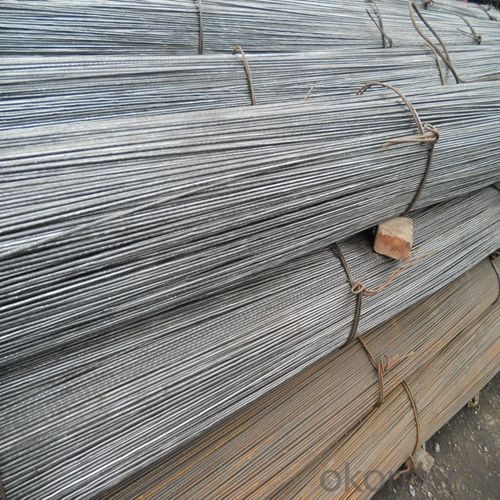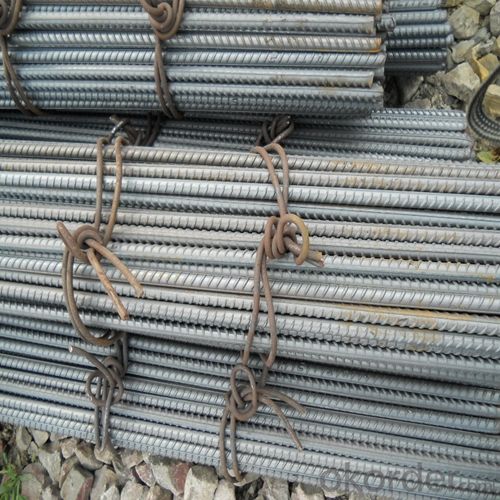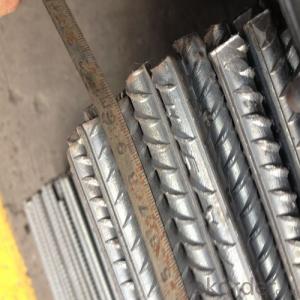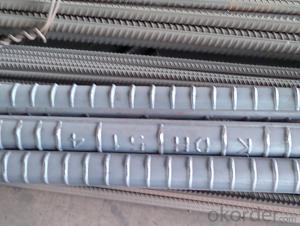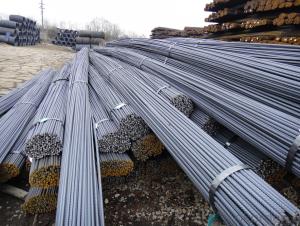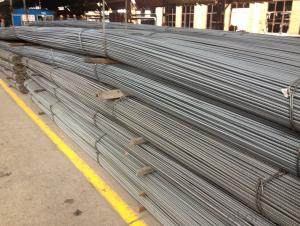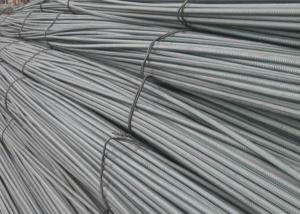Deformed Steel Bar Hot Rolled HRB4000 HRB500 ASTM A615 GR40/GR60
- Loading Port:
- Tianjin
- Payment Terms:
- TT OR LC
- Min Order Qty:
- 500 m.t.
- Supply Capability:
- 30000 m.t./month
OKorder Service Pledge
OKorder Financial Service
You Might Also Like
Product Description:
Specifications of HRB500 Deformed Steel Bar:
Standard | GB | HRB500 |
Diameter | 6mm,8mm,10mm,12mm,14mm,16mm,18mm,20mm, 22mm,25mm,28mm,32mm,36mm,40mm,50mm | |
Length | 6M, 9M,12M or as required | |
Payment term | TT or L/C | |
Application | mainly used in construction industry to reinforce concrete structures and so on | |
Quality | First quality, the goods are from Chinese big manufacturers. | |
Type | Hot rolled deformed steel bar | |
Brand name | DRAGON | |
Chemical Composition: (Please kindly find our chemistry of our material based on HRB500 as below for your information)
Grade | Technical data of the original chemical composition (%) | ||||||
C | Mn | Si | S | P | V | ||
HRB500 | ≤0.25 | ≤1.60 | ≤0.80 | ≤0.045 | ≤0.045 | 0.08-0.12 | |
Physical capability | |||||||
Yield Strength (N/cm²) | Tensile Strength (N/cm²) | Elongation (%) | |||||
≥500 | ≥630 | ≥12 | |||||
Theoretical weight and section area of each diameter as below for your information:
Diameter(mm) | Section area (mm²) | Mass(kg/m) | Weight of 12m bar(kg) |
6 | 28.27 | 0.222 | 2.664 |
8 | 50.27 | 0.395 | 4.74 |
10 | 78.54 | 0.617 | 7.404 |
12 | 113.1 | 0.888 | 10.656 |
14 | 153.9 | 1.21 | 14.52 |
16 | 201.1 | 1.58 | 18.96 |
18 | 254.5 | 2.00 | 24 |
20 | 314.2 | 2.47 | 29.64 |
22 | 380.1 | 2.98 | 35.76 |
25 | 490.9 | 3.85 | 46.2 |
28 | 615.8 | 4.83 | 57.96 |
32 | 804.2 | 6.31 | 75.72 |
36 | 1018 | 7.99 | 98.88 |
40 | 1257 | 9.87 | 118.44 |
50 | 1964 | 15.42 | 185.04 |
Usage and Applications of HRB500 Deformed Steel Bar:
Deformed bar is widely used in buildings, bridges, roads and other engineering construction. Big to highways, railways, bridges, culverts, tunnels, public facilities such as flood control, dam, small to housing construction, beam, column, wall and the foundation of the plate, deformed bar is an integral structure material. With the development of world economy and the vigorous development of infrastructure construction, real estate, the demand for deformed bar will be larger and larger..
Product Description:
Quick Details
Standard:ASTM, BS, GB, JIS
Grade:HRB335
Diameter:6-50mm
Length:6-12m
Place of Origin:Tianjin, China (Mainland)
Application:construction
Deformed Steel Bar:Original Tianjin China
Standard1:BS4449
Standard2:ASTM A615
Standard3:GB/T1449
Grade1:HRB335
Grade2:HRB400
Grade3:HRB500
Grade4:460B
Grade5:GR.40
Grade6:GR.60
Packaging & Delivery
| Packaging Details: | with bundle and bare packing |
|---|---|
| Delivery Detail: | within 15-20days |
Specifications
Deformed Steel Bar
1).Standard:BS4449 ASTM A 615
2).Grade:HRB335/400/500,460B,GR40/60
3) Experience : 5years for exporting
| Tianjin Baolf Steel Co.,Limited | |
| Standard | BS4449 ASTM A615 GB/T1499 |
| Grade | HRB335/400/500,460B,GR40/60 |
| Diameter | 6-50mm |
| Length | 6,9,12m |
| Technique | Hot Rolled |
| Application | For Construction |
- Q: What are the common defects or issues associated with steel rebars?
- Steel rebars can encounter various defects or issues, including the following: 1. Rust: When exposed to moisture or corrosive substances, steel rebars are prone to rusting. This rust weakens their load-bearing capacity and compromises the structural integrity of the reinforced concrete. 2. Poor bonding with concrete: Inadequate cleaning or the presence of rust can prevent rebars from bonding well with the concrete. This can result in reduced strength and durability of the reinforced concrete structure. 3. Incorrect size or shape: Structural problems can arise from rebars that are improperly sized or shaped. For instance, rebars that are too short or have insufficient coverage might not provide enough reinforcement, making the structure susceptible to cracking or collapse. 4. Improper placement: Weak points in the reinforced concrete can occur due to incorrect rebar placement. This can happen when rebars are not adequately spaced, aligned, or when there are gaps between the rebar and the concrete. 5. Inappropriate storage and handling: To prevent rust, it is crucial to store rebars in a dry and well-ventilated area. Improper storage or handling can lead to surface damage, bending, or twisting of the rebars, affecting their performance in reinforced concrete. 6. Welding defects: Welded rebars may have defects such as insufficient fusion, cracks, or lack of penetration. These defects can compromise the strength and integrity of the reinforcement. 7. Overlapping issues: Overlapping rebars is a common practice to ensure reinforcement continuity. However, improper overlapping, such as insufficient overlap length or inadequate lapping of rebars, can result in weak joints and reduced structural strength. 8. Quality control concerns: Defects or issues in rebars can arise from inadequate quality control during manufacturing or installation. This can encompass problems like improper chemical composition, inadequate strength, or deviations from specified standards. Addressing and rectifying these defects or issues during the design, manufacturing, and construction stages is crucial to ensure the safe and reliable performance of reinforced concrete structures. Regular inspection, maintenance, and adherence to industry standards and guidelines are essential in mitigating these common issues associated with steel rebars.
- Q: Are steel rebars prone to rusting?
- Yes, steel rebars are prone to rusting.
- Q: What are the guidelines for proper anchoring of steel rebars in concrete structures?
- For the structural integrity and stability of the construction, it is crucial to properly anchor steel rebars in concrete structures. Here are the guidelines for proper anchoring: 1. Embedment length: To ensure sufficient bond strength, the rebars should be embedded in the concrete for a specific length. The required embedment length depends on factors such as rebar diameter, concrete strength, and load conditions, as specified in the design. 2. Lap length: When joining two rebars, a minimum lap length is necessary for reinforcement continuity. The lap length is determined by the rebar diameter, concrete strength, and structural design requirements. 3. Concrete cover: To safeguard the rebars from corrosion and fire, adequate concrete cover should be provided. The concrete cover is the distance between the outer surface of the rebars and the nearest concrete surface. It depends on factors like environmental conditions, fire resistance requirements, and durability considerations. 4. Spacing and arrangement: The rebars should be appropriately spaced and arranged according to the structural design requirements. The spacing is determined by the structural load and design specifications. Inadequate spacing can compromise the structural strength by providing insufficient reinforcement. 5. Proper positioning: Accurate positioning of rebars is essential, following the design drawings and specifications. They should be placed in the concrete formwork before pouring to achieve the desired structural behavior. Incorrect positioning can result in misalignment or insufficient concrete cover. 6. Mechanical anchorage: Mechanical anchorage devices such as rebar couplers, anchor bolts, or hooks can be utilized to enhance rebar anchoring in concrete structures. These devices provide additional reinforcement and prevent slippage or pull-out of the rebars under load. 7. Quality control: Regular inspection and quality control measures should be implemented to ensure compliance with the anchoring guidelines. This includes checking rebar dimensions and spacing, embedment depth, concrete cover, and ensuring proper installation techniques. It is important to note that these guidelines may vary based on project requirements, local building codes, and design specifications. Therefore, consulting a structural engineer or referring to relevant building codes and standards is essential for specific guidelines applicable to each construction project.
- Q: What is the process of inspecting steel rebars on-site?
- The quality and adherence to specifications of steel rebars on-site are ensured through a series of steps in the inspection process. Firstly, a visual inspection is conducted to identify any visible defects or damage, such as rust, cracks, bends, or improper dimensions. Immediate attention is given to any issues found. Next, accurate measurements are taken using tools like calipers or measuring tapes. The length, diameter, and shape of each rebar are compared against the project specifications to ensure they meet the required dimensions. For certain projects, chemical analysis of the steel rebars may be necessary to confirm their composition and strength. Samples are taken from different batches and sent to a lab for testing, with the results determining compliance with standards. Non-Destructive Testing (NDT) techniques are utilized to evaluate the internal integrity of the rebars without causing damage. Ultrasonic testing, magnetic particle inspection, and radiography are employed to detect hidden defects like cracks, voids, or inclusions. If welding is involved, the inspector checks the welds for proper penetration, alignment, and quality. This guarantees the strength and integrity of the joint. Throughout the inspection process, detailed records are maintained. These records include information about the inspections conducted, measurements taken, test results, and identified defects. They serve as evidence of compliance and can be referred to in case of disputes or future reference. Once the inspection is complete, a detailed report is prepared summarizing the findings. This report is shared with the project management team, engineers, and other relevant stakeholders. It highlights any non-compliance, defects, or areas that require attention. In conclusion, the on-site inspection of steel rebars is a comprehensive and systematic approach that ensures their quality, integrity, and compliance with project specifications and industry standards.
- Q: What are the different types of steel rebars used in underground constructions?
- Underground constructions commonly employ various types of steel rebars, each serving a specific purpose. These rebars fortify concrete structures, enhancing their durability and strength. 1. Carbon Steel Rebars: The most prevalent kind of rebar used underground is carbon steel rebars. They boast high tensile strength due to their composition of carbon steel, rendering them suitable for diverse applications. 2. Epoxy-Coated Rebars: Carbon steel rebars receive an epoxy coating, transforming them into epoxy-coated rebars. This protective layer makes them resistant to corrosion, rendering them ideal for underground constructions where moisture and chemicals are present. 3. Stainless Steel Rebars: Stainless steel rebars offer exceptional resistance to corrosion and possess excellent strength properties. They are commonly employed in underground constructions that anticipate extreme environmental conditions, such as high humidity or exposure to saltwater. 4. Galvanized Rebars: Carbon steel rebars undergo a zinc coating process, resulting in galvanized rebars. This coating enhances their corrosion resistance, making them suitable for underground constructions situated in areas with elevated moisture levels or exposure to chemicals. 5. Fiberglass Rebars: Fiberglass rebars consist of glass fibers embedded within a resin matrix. They are lightweight, corrosion-resistant, and possess high tensile strength. Fiberglass rebars are frequently utilized in underground constructions that necessitate non-magnetic properties, such as proximity to sensitive equipment or areas susceptible to electromagnetic interference. The selection of a specific type of steel rebar for an underground construction project is based on its unique advantages and the project's specific requirements. Factors such as environmental conditions, load-bearing capacity, and anticipated lifespan are carefully considered when determining the appropriate steel rebar for a particular application.
- Q: What are the different types of steel rebars used in beam reinforcement?
- Different types of steel rebars are commonly utilized for beam reinforcement. These include: 1. Mild Steel Rebars (MSR): Low carbon steel is used to produce these rebars, which are widely employed due to their affordability and availability. They possess a yield strength of 250 MPa and are suitable for general construction purposes. 2. High Yield Strength Rebars (HYSD): These rebars exhibit a higher yield strength in comparison to mild steel rebars, typically ranging from 415 MPa to 600 MPa. They find common usage in heavy-duty and high-stress applications, such as bridges and high-rise buildings. 3. Carbon Steel Rebars: Carbon steel rebars are manufactured from steel with a higher carbon content than mild steel rebars. They offer enhanced strength and ductility, making them appropriate for areas prone to corrosion and seismic zones. 4. Stainless Steel Rebars: Stainless steel rebars are produced using steel with a high chromium content and other alloying elements. They possess excellent corrosion resistance, making them ideal for structures exposed to harsh environments like marine applications or chemical plants. 5. Epoxy-Coated Rebars: These rebars are coated with an epoxy layer to provide additional protection against corrosion. Epoxy-coated rebars are frequently utilized in structures exposed to moisture or chloride-rich environments, such as coastal regions or areas with deicing salts. It is crucial to consider the specific requirements and conditions of the project when selecting the type of steel rebar for beam reinforcement. It is recommended to consult with structural engineers or industry professionals to ensure the appropriate material is chosen for optimal performance and longevity of the reinforced beam.
- Q: How do steel rebars affect the overall sustainability certifications of a structure?
- The sustainability certifications of a structure can be significantly influenced by steel rebars. Certifications like LEED or BREEAM assess a building's environmental performance based on various factors, including the materials used. The sustainability of a structure can be affected by the production and use of steel rebars in several ways. Firstly, the production of steel consumes a significant amount of energy and emits greenhouse gases. However, many steel manufacturers have implemented energy-efficient technologies and use recycled materials to reduce their environmental impact. Therefore, the sustainability of steel rebars depends on production methods and the extent of recycled content. The durability and longevity of steel rebars also play a crucial role in a structure's sustainability. Steel's strength and resilience can greatly enhance a building's lifespan, reducing the need for frequent repairs and replacements. This reduces material waste and energy consumption associated with ongoing maintenance. Moreover, steel rebars contribute to a building's overall structural efficiency. By reinforcing concrete, they improve structural integrity and load-bearing capacity, allowing for more efficient use of materials. This leads to reduced material consumption and waste during construction, which is vital for sustainability. Additionally, steel rebars can be recycled at the end of a building's life cycle. Steel is a highly recyclable material that can be repurposed into new rebars or other steel products, reducing the demand for new materials. This recycling process further minimizes the environmental impact of steel production. In conclusion, steel rebars impact the sustainability certifications of a structure through production methods, durability, structural efficiency, and recyclability. By employing sustainable production methods, enhancing durability, optimizing material usage, and promoting recycling, steel rebars can positively contribute to a building's sustainability and help achieve higher sustainability certifications.
- Q: How do steel rebars affect the shrinkage and creep of concrete?
- Steel rebars can have a significant impact on the shrinkage and creep behavior of concrete. Shrinkage refers to the reduction in volume of concrete due to the loss of moisture during the drying process, while creep refers to the time-dependent deformation of concrete under sustained load. The presence of steel rebars helps to mitigate the shrinkage of concrete. As the concrete shrinks, the rebars, being much stiffer than concrete, resist this shrinkage and provide a restraining effect. This restraint reduces the overall volume change of the concrete and helps to minimize cracking that may occur due to shrinkage. Additionally, the tensile strength of the steel rebars allows them to distribute stress and prevent localized cracking, further reducing the impact of shrinkage on the overall performance of the concrete. In terms of creep, the presence of steel rebars can increase the creep deformation of concrete. This is because the rebars can introduce additional stress and strain into the concrete, leading to greater creep deflections. However, the effect of steel rebars on creep is generally considered to be minor compared to other factors such as the mix design, water-cement ratio, and curing conditions. It is important to note that proper design and detailing of the reinforcement layout can help minimize the impact of steel rebars on shrinkage and creep. Adequate spacing and cover of rebars, as well as appropriate reinforcement ratios, can optimize the performance of both the concrete and the rebars. Additionally, the use of supplementary cementitious materials like fly ash or silica fume can also help reduce shrinkage and mitigate the impact of creep. In summary, steel rebars play a crucial role in minimizing the shrinkage-related issues in concrete by providing restraint and distributing stress. While they may increase the creep deformation of concrete, their impact is generally minor compared to other factors. Proper design and detailing of the reinforcement can optimize the performance of both concrete and steel rebars in terms of shrinkage and creep.
- Q: How do steel rebars affect the acoustic properties of a structure?
- Steel rebars can have a significant impact on the acoustic properties of a structure. Due to their high density and rigidity, steel rebars can act as conductors of sound and vibrations. This means that when sound waves or vibrations encounter steel rebars, they can easily be transmitted through them, resulting in increased noise levels and reduced acoustic insulation. In terms of airborne sound transmission, steel rebars can create a direct pathway for sound waves to travel through a structure. This can lead to the amplification of sound, especially in areas where rebars are in direct contact with walls or floors. As a result, the overall acoustic quality of the structure may be compromised, causing increased noise levels and decreased speech intelligibility. Steel rebars can also affect the structure's ability to block impact or structure-borne noise. When vibrations are generated, for example, from footsteps or machinery, the rigid steel rebars can efficiently transmit these vibrations throughout the structure. This can result in the amplification and propagation of structure-borne noise, making it more perceptible in different areas of the building. To mitigate the negative effects of steel rebars on the acoustic properties of a structure, various techniques can be employed. One common method is to use acoustically decoupled materials or resilient mounts to isolate the rebars from the surrounding structure, reducing the transmission of vibrations. Additionally, incorporating sound-absorbing materials, such as acoustic panels or insulation, can help to absorb and dampen sound waves, improving the overall acoustic performance of the space. Overall, steel rebars can have a significant impact on the acoustic properties of a structure. Their high density and rigidity make them efficient conductors of sound and vibrations, potentially leading to increased noise levels and reduced acoustic insulation. Therefore, careful consideration of acoustic design and appropriate use of soundproofing measures are essential in minimizing the adverse effects of steel rebars on the acoustic quality of a building.
- Q: Can steel rebars be used in structures with long spans?
- Yes, steel rebars can be used in structures with long spans. Steel rebars are commonly used as reinforcement in concrete structures, including those with long spans such as bridges, high-rise buildings, and stadiums. The high tensile strength and durability of steel rebars make them suitable for withstanding the forces and stresses that occur in such structures.
Send your message to us
Deformed Steel Bar Hot Rolled HRB4000 HRB500 ASTM A615 GR40/GR60
- Loading Port:
- Tianjin
- Payment Terms:
- TT OR LC
- Min Order Qty:
- 500 m.t.
- Supply Capability:
- 30000 m.t./month
OKorder Service Pledge
OKorder Financial Service
Similar products
Hot products
Hot Searches
Related keywords
